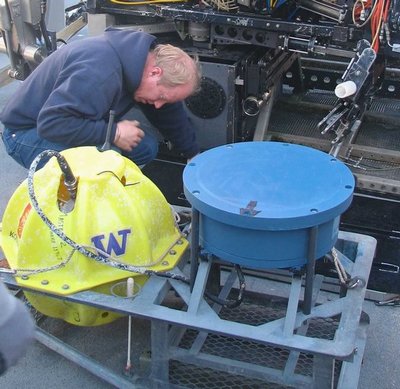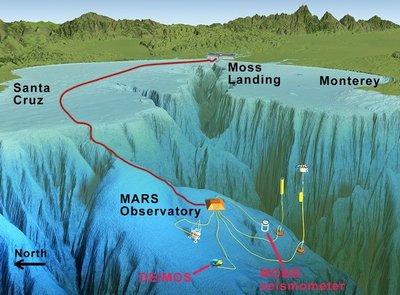April 9, 2009
DEIMOS joins MARS and its satellite of instruments on seafloor
The planet Mars has a moon named Deimos, so it seems only appropriate that the ocean observatory MARS in Monterey Bay have its own DEIMOS. This DEIMOS, however, is an underwater acoustic package designed to monitor movements of fish and zooplankton.
MARS, which stands for Monterey Accelerated Research System, consists of a node the size of two compact cars that serves as both a power strip and a high-speed internet connection for scientific instruments. Connected to the California coast by a 35-mile-long cable carrying power and data, MARS went live late last fall 3,000 feet below the surface in Monterey Bay.
Most recently connected to the node is the UW-designed DEIMOS, which stands for Deepwater Echo Integrating Marine Observatory System. DEIMOS uses an echo sounder to transmit and receive an acoustic signal used to reveal what’s in a narrow cone of water above the instrument. DEIMOS can discern everything from zooplankton to whales.
DEIMOS was connected to MARS Feb. 28. For the past two weeks John Horne, UW associate professor of aquatic and fisheries sciences and leader of the DEIMOS project, has been able to sit in his office in Seattle and see the data as it is collected.
Scientists need to know the density, distribution and dynamics of what’s living in the water to understand how ocean life responds to tides, nutrients upwelling from deeper waters, storms, the changing seasons or El Niño events, Horne says. That information can then be used to investigate effects of long-term environmental changes.
It’s not new for biologists to use echo sounders. What’s new is that Horne’s package can be controlled from land and operate far longer than those relying on batteries, thanks to the power supplied via MARS. Horne said it took more than six car batteries to provide power for one week to an echo sounder he mounted on a buoy for a past project. To operate for a year on the seafloor, one can’t very well deploy an echo sounder package and 312 car batteries.
The Monterey Bay Aquarium Research Institute operates MARS as a test platform for the National Science Foundation’s Ocean Observatories Initiative. Researchers use MARS to test instruments before they are hooked up to deep-sea observatories off the U.S. and elsewhere.
MARS enables existing instruments to be used in new ways and the invention of entirely new instruments. Horne says DEIMOS shows what’s possible, even without a lot of money.
Horne and UW research scientists David Barbee and Dick Kreisberg did the design and engineering using off-the-shelf components costing roughly $14,500. The package includes a Simrad Fisheries echo sounder — similar to what fishermen use to locate fish — on loan from Kongsberg Underwater Technology, which has its U.S. headquarters in Lynnwood, Wash. The whole package had to meet certain size and weight restrictions, for example weighing less than 300 pounds, to be deployed by ROV Ventana, one of the institute’s remotely operated vehicles.
In addition to the restrictions on size, the UW team faced other challenges such as working out Internet protocols to communicate with the institute’s computer system and navigate firewalls without compromising security, Horne says.
DEIMOS emits an acoustic signal that spreads out in a cone shape from the 16.5-inch diameter transducer to a 115-yard circular area at the surface of the ocean and has been designed to not disturb marine mammals or other animals that are being monitored. Click here for more about DEIMOS.
Horne says he plans to coordinate acoustic data from DEIMOS with what is being recorded by a special low-light video camera called Eye-in-the-Sea that is also connected to MARS. Developed under the direction of marine biologist Edie Widder, the system records deep-sea animals in the area.
Funding for DEIMOS was provided by the UW School of Aquatic and Fisheries Sciences. Horne’s group received expertise and help from Tim McGinnis and Bruce Howe at the UW’s Applied Physics Laboratory and Tor Bjorklund at UW’s Oceanography Technical Services.
For more information:
• About MARS
• About Eye-in-the-Sea




